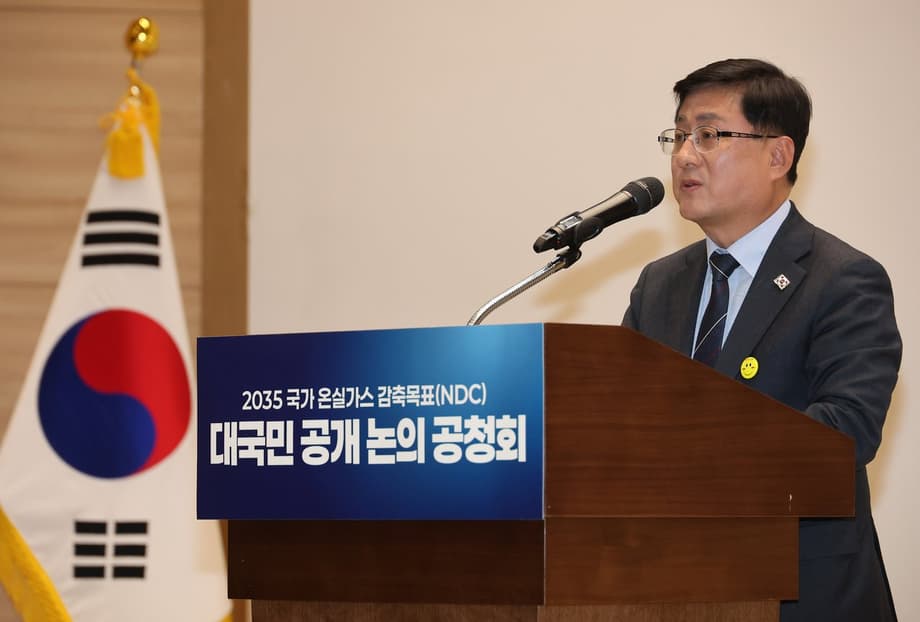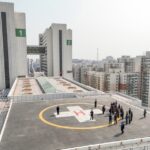Inside South Korea’s 2035 climate target debate
South Korea has outlined two options for its next climate pledge for 2035, setting the stage for a high stakes decision with domestic, legal, and trade consequences. The government is weighing a target to cut greenhouse gas emissions by either 50 to 60 percent or 53 to 60 percent from 2018 levels. A final proposal will go to the Cabinet and the Presidential Commission on Carbon Neutrality and Green Growth before submission to the United Nations. The numbers underscore the scale of the task. Emissions in 2018 were 742.3 million metric tons. A 50 percent cut would require getting to roughly 371.2 million tons by 2035. A 60 percent cut would mean about 296.9 million tons. Last year the country emitted an estimated 691.6 million tons, leaving a steep trajectory over the next decade. The new plan builds on an existing pledge from 2021 to reduce emissions by 40 percent by 2030, which has proved difficult to meet.
- Inside South Korea’s 2035 climate target debate
- What exactly did the government propose?
- Why activists say the target falls short
- Why industry warns the plan is unrealistic
- Is a 60 to 61 percent cut by 2035 technically possible?
- Legal and diplomatic context shaping the target
- What would need to change in key sectors
- How the process will unfold, and what to watch
- At a Glance
The announcement triggered a chorus of criticism. Environmental groups argue that the lower end is out of step with science and fairness standards under the Paris Agreement and the first Global Stocktake. They urge a floor of 61 percent by 2035, a level they say aligns with a 1.5 degrees Celsius limit on warming. Industry groups contend that even a high 40s target is hard, and warn of costs, supply chain strain, and job risks if policy and finance do not move in sync. The government chose a range to reflect uncertainty and divergent views, an approach some fear will translate into the lower bound becoming the de facto target. The choice will define how Korea manages the next wave of power sector reform, industrial transformation, transport electrification, and clean technology investment.
What exactly did the government propose?
Officials presented two options for the 2035 nationally determined contribution, the formal climate plan under the Paris Agreement. One would commit to a 50 to 60 percent reduction from 2018 levels by 2035. The other would set a slightly higher floor, 53 to 60 percent. The upper bound is the same in both and described as stretching but potentially achievable if technology deployment accelerates and enabling policies land on time. The government also shared sector concepts for how to divide the national goal, including steep cuts in the power system, moderate reductions in transport, and smaller cuts in heavy industry that reflect global competitiveness pressures and technology readiness.
Indicative sector pathways point to the power sector taking the largest early burden. Draft figures circulated during the hearing described power sector reductions on the order of roughly 69 to 75 percent by 2035, deep transport cuts in the 50 to low 60 percent range, and less intensive, mid to high 20 percent reductions in industry. The plan envisions more renewable energy, faster grid buildout, wider use of electric and hydrogen vehicles, and targeted investment in abatement technologies and efficiency. The government also noted that several economies have used target ranges for their next round of climate pledges, arguing that ranges can help manage uncertainty while keeping headline ambition intact.
Environment Minister Kim Sung-hwan framed the range as a way to balance divergent views across society while moving the economy toward net zero by mid century.
“We presented it in the form of a range, rather than a single target, to find a balance between civic groups and industry.”
He also urged urgency, pointing to the gap between current emissions and the 2035 trajectory.
“We must cut greenhouse gas emissions over the next decade by an amount three to four times what we have reduced so far. With the sense of urgency that the remaining ten years are our golden time for survival, we will accelerate a major transition across all sectors.”
Why activists say the target falls short
Civil society coalitions argue that the floor in the government’s plan is out of step with what science and international law now require. The first Global Stocktake in 2023 concluded that the world must cut net greenhouse gas emissions by about 60 percent by 2035 from 2019 levels to keep a 1.5 degrees Celsius limit within reach. Since South Korea is a high income economy with large historic and current emissions within the OECD, domestic groups say fairness principles mean doing more than the global average. Environmental organizations, including the Korean Federation for Environmental Movements, call for a minimum 61 percent reduction from 2018 levels by 2035, with some platforms proposing 65 percent.
Legal developments sharpen their case. In August 2024, South Korea’s Constitutional Court recognized a constitutional right to protection from the climate crisis and found the 2030 plan insufficient to safeguard fundamental rights, pressing the government to adopt science based and fair targets. At the international level in 2025, the International Court of Justice stated in an advisory opinion that countries have limited discretion in setting climate pledges under international law. The opinion explained that if pledges are not as ambitious as possible in line with the 1.5 degrees goal, they can amount to an internationally wrongful act. Activists argue that a floor below 60 percent risks failing both the domestic constitutional standard and the new international benchmark. They also warn that adopting a range invites slippage toward the lower end, reducing accountability and clarity for investors and local governments.
Why industry warns the plan is unrealistic
Automotive, steel, petrochemical, and cross sector business groups have urged caution. Industry associations argue that the current trajectory already falls short of the 2030 pledge, and say that adding another steep step by 2035 without detailed road maps, financing, and regulatory reform puts production and jobs at risk. Automotive groups point in particular to the scale of transport electrification embedded in the scenarios. Internal projections circulated by industry estimate that hitting a mid 50s target for 2035 would require, by 2030, cumulative registrations of close to 9.5 million zero emission vehicles, roughly one third of the national fleet. They note that domestic electric vehicle sales have slowed in recent years and that charging networks, grid connections, and fleet turnover cycles lag the pace implied by the models.
Steelmakers and petrochemical firms point to technology constraints and global competition. Blast furnace based steelmaking is carbon heavy by design, and while clean alternatives like direct reduced iron with hydrogen and electric arc furnaces are advancing, capacity changes take time and capital. Industry groups ask for clear sector guidance, predictable timelines, and stronger tools, including tax credits, concessional finance, faster permitting for clean energy and infrastructure, and support for early projects that prove new processes at scale. They also flag trade exposure. Companies that supply the European Union face the Carbon Border Adjustment Mechanism, which will apply a charge on imports based on embedded emissions from 2026. Firms worry that moving faster than competitors without support could erode margins at a sensitive time.
One senior business official, speaking about the balance between climate targets and competitiveness, urged the government to calibrate the pace.
“There is no need to move ahead of others and face a headwind in environmental regulation. We need to adjust the pace.”
Is a 60 to 61 percent cut by 2035 technically possible?
Recent modeling suggests that an economy wide reduction of 60 to 61 percent by 2035 is technically feasible for South Korea if policies prioritize mature technologies, accelerate clean power, and focus on efficiency. A joint study using the Global Change Analysis Model, led by Solutions for Our Climate with partners at the University of Maryland, finds that a 61 percent cut by 2035 is achievable with a conservative pathway centered on proven options. The scenario phases out coal power, avoids new liquefied natural gas power construction, scales solar and wind at speed with energy storage, electrifies transport, and shifts steelmaking away from blast furnaces. The analysis deliberately minimizes reliance on high uncertainty technologies such as large scale carbon capture, hydrogen co firing in power, or ammonia cofiring.
A separate assessment using an integrated model examined current Korean policies and a more ambitious package. It concluded that existing policies would likely deliver only around a mid 30 percent cut by 2035 relative to 2018, short of the 2030 pledge. Under an enhanced package, the study found a pathway to roughly a 60 percent reduction, without the need for international offsets. The main drivers are faster offshore wind deployment, a firm coal phase out, restrictions on extending the life of blast furnace capacity, and strong building efficiency and electrification standards.
Key measures identified by these studies include:
- Complete retirement of coal fired power plants by 2035, and cancellation of proposed new gas fired capacity, paired with rapid buildout of solar, wind, and energy storage.
- Major grid investment to connect renewables, speed interconnection queues, and manage variability with demand response and storage.
- Transition in steelmaking from blast furnaces to electric arc furnaces using scrap, with early hydrogen based direct reduced iron pilots and procurement policies that create a market for low carbon steel.
- Electrification of transport across light duty, buses, and delivery fleets, combined with charging infrastructure, fleet targets, and fuel efficiency standards for remaining combustion models.
- Stronger building codes and incentives for deep retrofits and heat pumps in homes and commercial buildings, cutting gas demand and peak loads.
- Upgrades to the emissions trading system and carbon pricing to drive least cost abatement and fund transition support for workers and communities.
These pathways do not depend on speculative technologies. They rely on proven equipment and policy tools already in use across many markets. The challenge is speed, coordination, and credibility of delivery.
Legal and diplomatic context shaping the target
South Korea’s 2035 decision arrives amid a tightening legal and diplomatic frame for climate action. Under the Paris Agreement, countries must submit new or updated climate plans for 2035, informed by the first Global Stocktake. The Stocktake urged deep cuts by 2035, rapid power sector shifts, and a sharp scale up of renewable energy and energy efficiency. The International Court of Justice advisory opinion in 2025 went further, explaining that states have obligations under international law to prevent serious climate harm, and that pledges must be as ambitious as possible in light of the 1.5 degrees goal and national capabilities. It warned that weak contributions may breach legal duties and trigger responsibility to other states.
Domestically, the Constitutional Court’s 2024 ruling recognized citizens’ rights to protection from the climate crisis and criticized the 2030 plan’s lack of alignment with science and equitable burden sharing. Lawmakers are now moving to legislate a national reduction pathway for 2031 to 2049, which will have to match or exceed the 2035 target and provide predictable annual milestones. These changes elevate the legal stakes of the government’s choice. Setting a floor that aligns with 1.5 degrees and fairness would reduce litigation risk. A lower floor, critics say, could invite domestic lawsuits and international scrutiny.
Trade and competitiveness also shape the decision. The European Union is phasing in its carbon border charge. Global buyers are prioritizing low carbon supply chains for batteries, steel, and shipbuilding, sectors where Korea seeks growth. A strong, credible target with clear delivery policies can attract private capital and unlock export opportunities. Recent polling of Korean business leaders indicates broad support for a rapid shift to a renewables based power system within a decade, signaling that many firms see clean electricity as a competitiveness strategy as much as an environmental goal.
What would need to change in key sectors
Moving from headline targets to credible delivery requires concrete moves in power, industry, transport, and buildings. The government has outlined early concepts, and independent studies map out practical steps that use familiar technologies while avoiding over reliance on uncertain solutions.
Power
The backbone of deep cuts is a clean grid. Coal retirements need binding dates and financing tools for just transition in coal communities. New gas projects face a reassessment if the goal is to prevent lock in and meet the 2035 trajectory. Solar and wind additions must accelerate beyond current plans, paired with battery storage and demand flexibility so that the system can handle high shares of variable generation. Permitting and land use rules are a major bottleneck. Accelerated approvals, better community benefit sharing, and upgraded transmission will be necessary to match the pace of change implied by a 60 percent national cut.
Industry
Heavy industry emits a large share of Korea’s carbon dioxide. Steel producers can expand scrap based electric arc capacity and plan for hydrogen direct reduced iron where scrap is limited, backed by public procurement for low carbon materials. Chemical producers can pursue electrified heat, efficiency, and process redesign. Government can support risk sharing for first of a kind projects with loan guarantees and contracts for difference that bridge the price gap for cleaner products.
Transport
Electrifying cars, buses, and delivery fleets is central to the models that reach 60 to 61 percent. That means scaling domestic charging, improving grid readiness at depots and apartment blocks, and using clear fleet mandates and incentives that reward faster turnover. Interim measures such as hybrids can help reduce fuel use, but the long term trajectory requires zero emission vehicles to reach a large share of new sales well before 2035. Urban planning, public transit, and logistics efficiency can deliver additional mileage and freight gains that ease the pressure on vehicle sales targets.
Buildings and cities
Stronger efficiency standards for new buildings, an accelerated timetable for retrofits, and widespread adoption of heat pumps can cut gas demand and peak loads. Cities can lead, using public procurement, district energy, and building performance standards to drive investment and anchor supply chains for efficient equipment. These steps reinforce the power and industry transitions by lowering overall energy demand and making it easier to integrate renewables.
How the process will unfold, and what to watch
The government plans to finalize the 2035 target after reviews by the Presidential Commission and the Cabinet, then submit it to the UN climate secretariat. A public hearing process is underway, and a final choice between a 50 percent floor and a 53 percent floor is expected soon. The target will shape sector plans due in the coming year, including updated power supply plans and transport road maps. The National Assembly is also expected to legislate a 2031 to 2049 emissions pathway that aligns with the new 2035 pledge.
Several signals will reveal how credible the target is in practice. First, the lower bound. A floor at 53 percent, paired with strong sector road maps, would send a firmer signal than a 50 percent floor. Second, power sector timelines. Binding coal retirement schedules, a halt to new gas capacity, and grid investment announcements would show delivery intent. Third, transport policy detail. Excise tax, fleet mandates, charging funding, and rules for buses and trucks will determine whether electrification can scale. Fourth, industry support. New finance tools, procurement standards, and emissions trading reforms can move projects from plans to groundbreakings. Finally, transparency. Annual budgets, progress dashboards, and contingency plans will keep the country on course if the economy jolts.
At a Glance
- Government presented two 2035 options, a 50 to 60 percent cut or a 53 to 60 percent cut from 2018 emissions.
- 2018 emissions were 742.3 million tons, with 2023 at about 691.6 million tons. A 50 percent cut implies roughly 371.2 million tons by 2035, a 60 percent cut about 296.9 million tons.
- Environmental groups seek at least a 61 percent cut by 2035, citing the Global Stocktake and fairness for a high income emitter.
- Industry groups warn targets are unrealistic without detailed sector plans, finance, and regulatory reform.
- Minister Kim Sung-hwan says a range balances views and calls for urgency across all sectors.
- Modeling shows a 60 to 61 percent cut is feasible using proven measures, including a coal phase out, no new gas power, renewables and storage, industrial shifts, and transport electrification.
- The Constitutional Court’s 2024 ruling and the International Court of Justice advisory opinion push toward science based, fair, and ambitious pledges.
- Trade pressures such as the EU carbon border charge add incentives for lower carbon exports and clean power.
- Next steps include Cabinet approval and UN submission, followed by sector road maps and legislation of a 2031 to 2049 pathway.
- Signals to watch: the final floor, power sector timelines, transport policy detail, industry finance tools, and transparent progress tracking.




